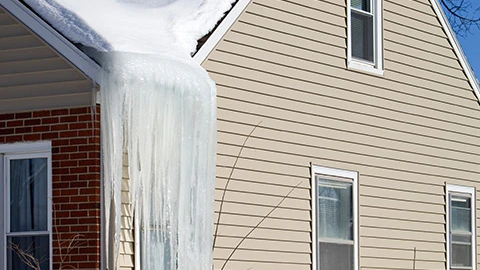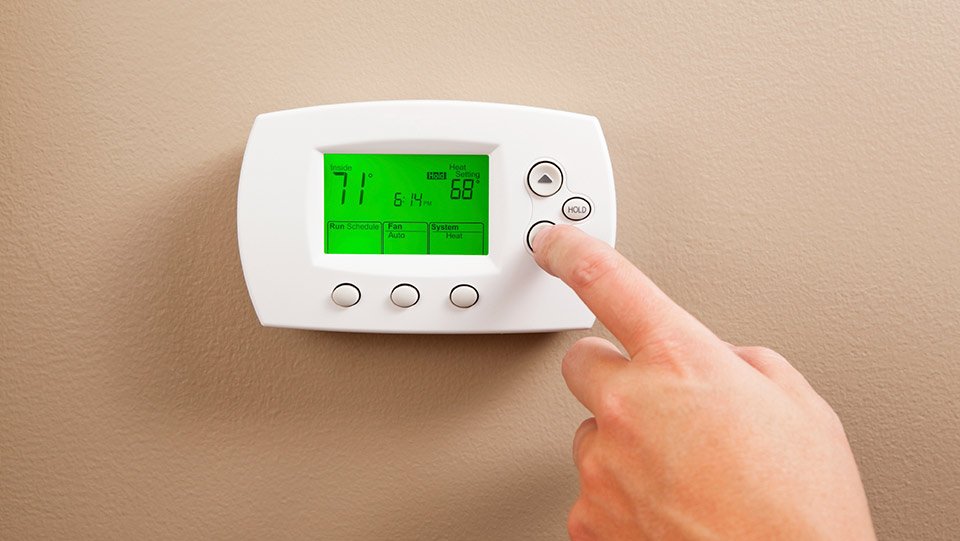How to Identify and Help Remove an Ice Dam

Travelers is proud to work with the finest Independent Agents
(DESCRIPTION)
Logo, a red umbrella. Text, Travelers. Identifying and Removing Ice Dams. Snow covers the roof of a home.
(SPEECH)
SPEAKER: Ice dams can form when heat escaping from your attic melts the snow on your roof.
(DESCRIPTION)
The snow melts to the edges of the roof.
(SPEECH)
When the melting snow reaches the edge of your roof, it refreezes forming ice. Once this happens, the ice blocks the water from draining properly from your roof. That can lead to water backing up underneath your shingles, seeping into your home, and causing serious water damage to your ceiling, walls, and insulation.
To help spot an ice dam, here are some key things to look for. One, water stains or moisture in your attic or along ceilings of your house, and two, large icicles on your roof's edge or ice forming over your gutters.
(DESCRIPTION)
Icicles form around the edge of the roof.
(SPEECH)
To help remove an ice dam, you'll need three basic items. One, a roof rake, two, calcium chloride ice melt found at your local hardware store. Don't use rock salt as this can damage your roof. Three, a nylon stocking.
Now you're ready. First, use the roof rake to remove three to four feet of snow from the edge of your roof. Next, fill a nylon stocking with the ice melt. Finally, place the nylon stocking vertically across the ice dam to melt a channel through the ice.
(DESCRIPTION)
A person calls a contractor on their mobile phone.
(SPEECH)
If you aren't able to reach your roof safely, hire a contractor to help.
(DESCRIPTION)
A van with a hammer on the side arrives at the home. Logo, a red umbrella. Text, Travelers.
(SPEECH)
Talk to your Travelers representative or independent agent today.
(DESCRIPTION)
Travelers dot com. Travelers Casualty and Surety Company of America and its property casualty affiliates. One Tower Square, Hartford, Ct 06183. This material does not amend or otherwise affect the provisions of any insurance policy issued by Travelers. It is not a representation that coverage does or does not exist for any particular claim or loss under any such policy. Coverage depends on the facts and circumstances involved in the claim or loss, all applicable policy provision, and any applicable law.
Sometimes, even your best efforts to prevent an ice dam may not be enough. Knowing what an ice dam is, how to identify one and how to help remove it is important to protect your roof and home from potential damage during the snowy winter months.
What is an ice dam?
Ice dams may form when water from melting snow freezes into ice at the edge of your roofline. Without proper roof snow removal, the ice that develops may grow large enough to prevent water from melting snow from properly draining off the roof. When the water is unable to drain from the roof, it may then back up underneath roof shingles and make its way into your home.
Do you have an ice dam?
Most ice dams develop on the edge of your roof, but they may also form in other locations, depending on the slope, orientation and style of your roof. Be sure to monitor the weather and your roof for signs of ice dam formations.
- Look closely at the icicles around the exterior of your house. If the icicles are confined to the gutters and there is no water trapped behind them, then an ice dam has likely not formed. Nonetheless, icicles can be a precursor to ice dams. Depending on their location and size, icicles may also pose a danger if they fall off. Whenever possible, and if safe to do so, remove icicles from the exterior of your home, making sure not to stand directly beneath them. If you cannot safely reach the icicles from the ground, consider hiring a contractor to assist in their removal.
- Check for water stains or moisture in your attic or along the ceiling of exterior walls of your house. Water stains or moisture may be an indication that an ice dam has formed and water has penetrated the roof membrane.
How to remove an ice dam
Removing an ice dam from your roof immediately after spotting the signs can be critical to helping prevent damage to your home. One way to remove an ice dam is to melt it using calcium chloride ice melt.
Step 1. Using a roof rake, remove snow 3-4 feet from the edge of your roof, being careful not to damage the roof covering or to allow snow to build up around walking paths or to block emergency exits.
Step 2. Use a calcium chloride ice melt product, which you can generally purchase from your local hardware store. Be sure not to use rock salt or sodium chloride, which can damage your roof.
Step 3. Fill a nylon stocking with the calcium chloride ice melt.
Step 4. Safely place and position the calcium chloride-filled nylon stocking vertically across the ice dam so that it can melt a channel through the ice.
Step 5. Cover and protect any shrubbery and plants with lightweight tarps near the gutters or downspouts for the duration that the calcium chloride stockings remain in place. This is important because the calcium chloride-saturated water dripping from the roof may damage the shrubbery and plants.
REMEMBER: Using a ladder in snowy and icy conditions may be dangerous. If you cannot safely reach the roof, consider hiring a contractor.



